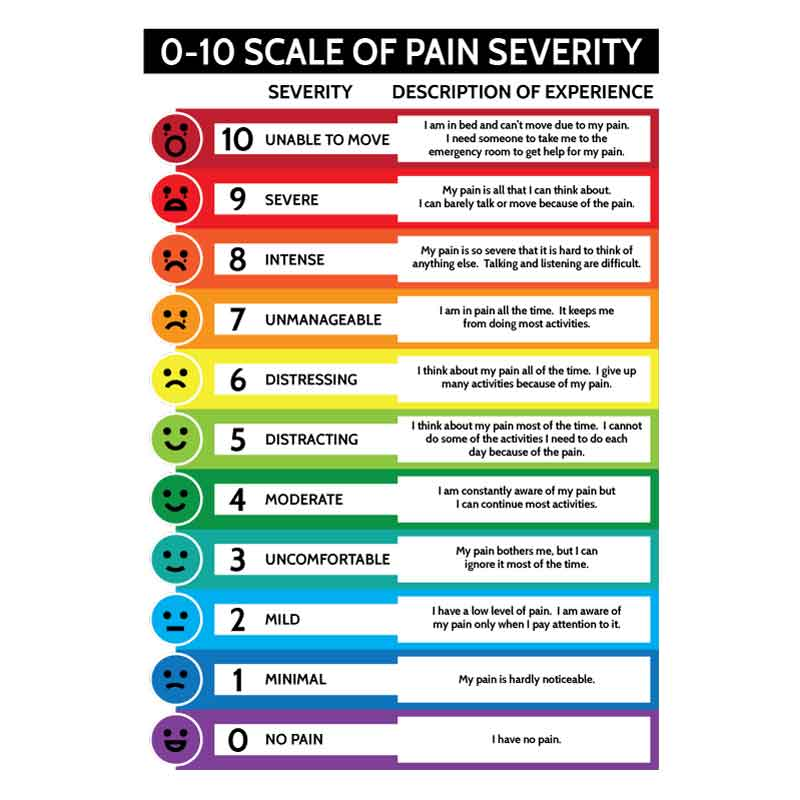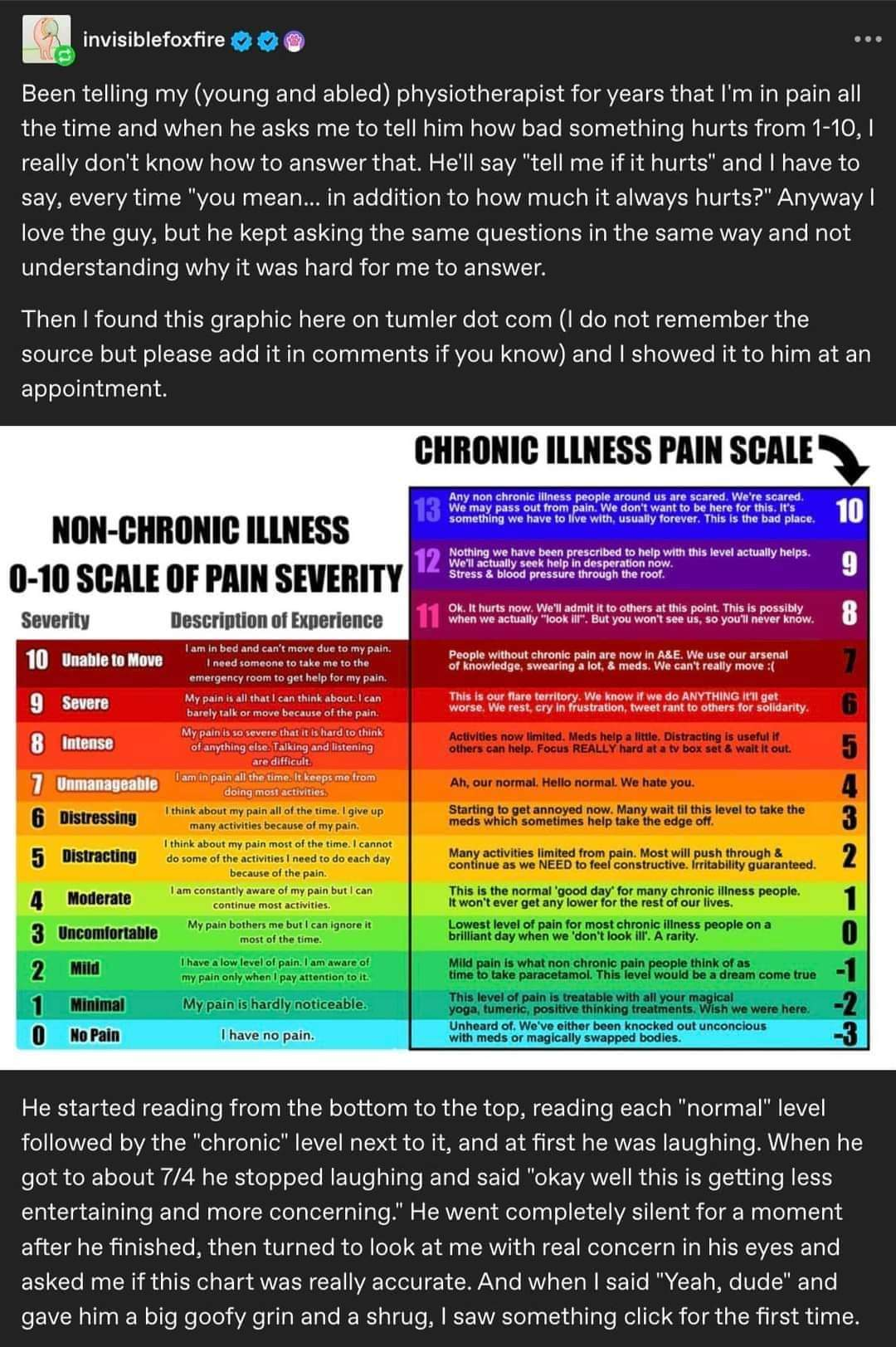During my assessment, the psychiatrist said she got as much out of my frequest requests for clarification as she did from the answers.
-“Do changes in your environment distress you?”
-“What type of changes and how big? Someone stealing my jacket, or my bus being delayed by 10 minutes? Does distress mean angry? Or annoyed? Can you give an example of what distress feels like, in the context of this question?”
Yeah, seeing how people respond to an open ended question is part of the assessment process itself. A lot of people can see that question and just say “yeah” or “nah” but you, and myself, see a huge gradient of possible scenarios and outcomes and need specificity
And if you’re a woman, 1-4 mean you’re making it up, 6-10 mean you’re being dramatic, and 5 means you’re being difficult for not being in one of the other categories.
They mainly want to know two things:
- Is it increasing or decreasing? This requires them to ask you multiple times over the course of treatment or multiple visits. For these purposes, the first number you choose isn’t that important. Just stay consistent and let that first decision anchor your later ones. But,
- Can they diagnose you based on pain severity? They have a range in their heads that corresponds to “appendicitis”, for example. If they tell you in advance whether you should be saying “8” for that, they’ll bias the diagnosis; you just have to pick one. If they have a diagnosis in mind and the number you choose is wildly off, they may discard that possibility and look for a closer match for diagnosis. If you pick something slightly outside that range, they’ll do more tests and exams and ask you more questions to see if the discrepancy is meaningless.
Bottom line, it’s fine to choose whatever feels right in the moment. Probably stay away from 10’s; a person with a 10 pain is probably unable to answer the question. You can answer “1” if they’re examining the wrong body part; if you broke your wrist and they’re prodding your leg, a 1 for your leg is totes fine, but make sure to give an answer that feels right when they poke your wrist.
(Besides, if pain severity is a factor in diagnosis, they can probably SEE you’re in pain. People in a lot of pain flinch, and sweat, and stutter, and move gingerly, and protect the extremities that are in pain. They know that. They can see it.)
Is that a scale based on how I’m feeling right now or in relation to the worst pain I’ve ever felt in my life. Because I had a kidney stone at 19 and it was so back when I went to convenient care people thought I was an addict just looking for drugs
inb4
Pain assesment remains a challenge due to its subjective nature and multidimensional characteristics. This study introduces a novel approach utilizing a multimodal model embedding, with inputs from a comprehensive anamnesis and sensor data, to estimate pain levels. By leveraging the Dimensionally Insensitive Euclidean Metric (DIEM), we ensure robust integration of heterogenous data streams, allowing for a reliable and scalable method to quantify pain in clinical and research settings.
Link?
I made it up
LPT: If you want the doctor to take you seriously never say less than 6.
I feel like 6 would be my arm is broken at the very least
Arm broken isn’t that Bad tbh, when it happens you get a lot of adrenalin so the initial break isn’t that Bad. And then if you’re just sitting around with it broken it doesn’t really hurt unless you move it.
Source: broke forearm and had to wait a week after to get surgery to put plates in. So I kinda just walked around with a bent arm in a sling for a week
Or more than 7 … If you’re not screaming at 8 they won’t believe you either

Why they never show this scale when asking about pain, I don’t know.
Because the faces have no consistency lmao, pain rated at 5 shouldn’t look happier than rank 1
I was gonna say, 5-1 look flipped. “Yay, my constant pain is making me unable to live my life!”
Why not? Rank 1 pain is just boring. 2 and 3 is where it gets more fun! /hj
Temporary pain can be fun (like leg cramps <3), but if it’s uncontrolled and continues for a long time it can be annoying. Definitely agree that the smiley choices on that sign seem a wee bit too masochistic to be making these signs for general use…
This one is a bit better for chronic pain.

My partner has chronic pain. I’m stealing this as a tool for future conversations. Thank you!
What the fuck, man, why is this so accurate? Reading the meme, I thought I’d rate my normal pain as a 4. Then I read the non-chronic pain scale and realized the description matches a 7, which is exactly where this chronic pain scale maps it.
When I was in an ambulance for an injury, the EMT asked me to rate my pain from 1 to 10. I said I didn’t know, because I have no frame of reference (because the whole concept of trying to rate pain objectively is stupid, but I didn’t say that).
He said just rate it anyway. I said 4. He said, “okay, there’s no way it’s 4” and dropped it.
Based on these descriptions, it was way higher than 4.
It’s not about having an obective answer to your pain levels, that’s impossible since everybody experiences pain differently.
I worked in the hospital for some time and it was my task to protocol those pain tables every day.
At least where I worked the point of it was to have visualisation of the patients pain development over time.
For example patients comes in and gives a 8 on the scale. He gets an operation and gives a 6 afterwards, after a week he gives a 5 but in the next week he gives 7 again - this development could tell us something about the healing process, maybe there’s an infection that would’ve slipped by if we didn’t see this unusual rise in pain levels.
Still seems dumb to dismiss a patient’s self-assessment like he did.
Yeah I wasn’t answering to your anecdote, just trying to illuminate the purpose of those charts and that their rating is inherently subjective.
Obviously being dismissive about it is not productive.
Although there were times where we asked patients to reassess them, almost always when their answers were in the high end of the scale, a dude sitting totally chill drinking tea answering ‘10’ is not really believable and could cloud what’s happening. I mostly described it as “1 being a mild inconvenience and 10 being the strongest pain you have ever felt in your life”
Yeah the pain one often gets people.
Pain is too subjective to measure effectively.
If someone says 9 or 10 you can assume it’s immense pain, likely the worst they’ve ever felt.
They are going for a vibe not an empirical answer.
Removed by mod
My pain was a 4 before you asked me, and a 9 now that I have to come up with a rating
What if I’m not really consciously aware of the pain I’m supposed to be feeling?
And what’s the point anyways? Just to determine if I need pain meds and what kind? Why even offer me a painkiller (even if just an OTC painkiller) when I said like 2 (maybe that was based on the xray rather than my self-report, but I exaggerated the pain up because I thought 0-1 would have made it even harder for them to take my injury seriously pre-xray)? Should I report the discomfort levels when I intentionally stress the injury or when in a comfortable position levels?
Sometimes it’s just to gauge how things change over time.
If you said 5 when you came in, but 3 after an hour, then we can make decisions based on what happened between those times.
If you said 3 when you came in but now it’s a 7, maybe there’s some emergency that needs to be acted on now.
If you said 9, and that makes sense based on what is going on, you get some nice drugs for a bit.
This has nothing to do with being autistic. But I guess being autistic makes it harder.
I would argue that it’s very much on-point. I routinely called out questions on tests because they had ambiguities that would mean the correct answer couldn’t be determined from the information provided.








